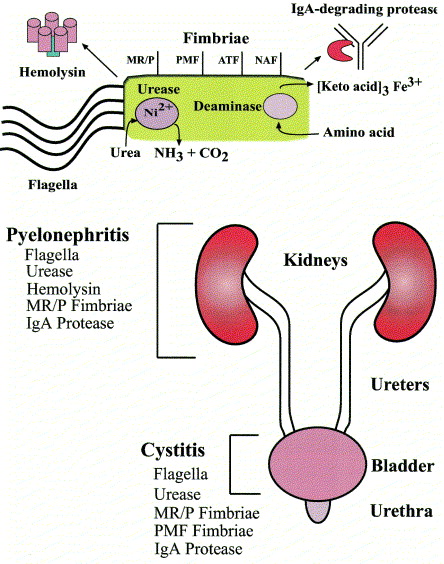Proteus pyelonephritis is a serious and potentially life-threatening bacterial infection of the renal parenchyma and collecting system caused predominantly by Proteus mirabilis. This gram-negative organism is known for its swarming motility, urease activity, and ability to form urinary stones, all of which contribute to its pathogenicity in upper urinary tract infections. Prompt recognition and targeted intervention are critical to prevent renal damage and systemic complications.

Microbiological Profile of Proteus Species in Renal Infections
Characteristics That Facilitate Renal Ascension
Proteus mirabilis, the primary culprit in most cases, exhibits several features that enhance its ability to ascend the urinary tract and colonize the kidneys:
- Swarming motility: Enables rapid movement through the urinary tract.
- Urease production: Alkalinizes urine, facilitating struvite stone formation and biofilm development.
- Fimbriae (adhesins): Mediate adherence to uroepithelial cells.
- Biofilm formation: Increases resistance to host immunity and antibiotics.
Epidemiology and Risk Factors
Populations at Increased Risk
While Proteus species are not the most common pathogens in pyelonephritis, their role becomes prominent in complicated urinary tract infections, particularly in:
- Individuals with long-term urinary catheters
- Patients with neurogenic bladder or urinary tract anomalies
- Men with prostatic hypertrophy
- Diabetics and immunocompromised individuals
- Recurrent UTI sufferers
- Those with kidney stones (struvite calculi)
Clinical Manifestations of Proteus Pyelonephritis
Hallmark Signs and Symptoms
Patients may present with a spectrum of symptoms depending on the severity of the infection:
- Flank pain and costovertebral angle tenderness
- High-grade fever with chills
- Nausea, vomiting, and malaise
- Cloudy, foul-smelling, or blood-tinged urine
- Lower urinary tract symptoms (dysuria, frequency, urgency)
- In severe cases: hypotension, confusion, or signs of sepsis
Persistent infection may lead to renal scarring, abscess formation, or urosepsis if untreated.
Laboratory and Imaging Workup
Diagnostic Highlights
- Urinalysis: Pyuria, bacteriuria, hematuria, alkaline pH
- Urine culture: Confirms Proteus spp., usually P. mirabilis
- Imaging: Non-contrast CT or renal ultrasound identifies obstruction, calculi, or renal abscess
- Blood cultures: Recommended in systemic symptoms or suspected urosepsis
Antimicrobial Treatment and Supportive Management
Empiric and Targeted Antibiotic Therapy
Initial empiric therapy must cover gram-negative organisms, especially those capable of beta-lactamase production. Choices include:
- Fluoroquinolones (e.g., ciprofloxacin, levofloxacin)
- Extended-spectrum cephalosporins (e.g., ceftriaxone, cefepime)
- Piperacillin-tazobactam for broad-spectrum coverage
- Carbapenems for multidrug-resistant strains
- Aminoglycosides (e.g., gentamicin) in severe or hospitalized cases
Treatment Duration
- Uncomplicated cases: 7–14 days
- Complicated or recurrent cases: 14–21 days or longer
Adjunctive Measures
- Adequate fluid hydration to promote diuresis
- Analgesics and antipyretics for symptom control
- Drainage or removal of obstructive stones or devices
- Surgical intervention in cases of abscess or emphysematous pyelonephritis
Complications of Untreated Proteus Pyelonephritis
Potential Sequelae
Delayed or inadequate treatment can lead to:
- Renal abscess or perinephric abscess
- Emphysematous pyelonephritis (gas-forming infection)
- Chronic kidney disease from scarring
- Struvite nephrolithiasis
- Urosepsis and septic shock
Prompt diagnosis and complete eradication of the infection are paramount to preventing these outcomes.
Prevention and Long-Term Management
Strategies to Minimize Recurrence
- Timely treatment of lower urinary tract infections
- Regular monitoring in patients with indwelling catheters
- Prophylactic antibiotics for high-risk individuals with recurrent infections
- Dietary modifications to reduce stone risk (e.g., reduced phosphate and protein intake)
- Addressing anatomical abnormalities or obstructive uropathy
Proteus pyelonephritis is a severe, often complicated renal infection requiring prompt and effective intervention. Understanding its unique pathophysiology, risk profile, and treatment approach is vital for clinicians managing urinary tract infections, especially in patients with structural abnormalities or recurrent disease. With appropriate antimicrobial therapy and vigilant follow-up, outcomes can be significantly improved and long-term renal complications avoided.

